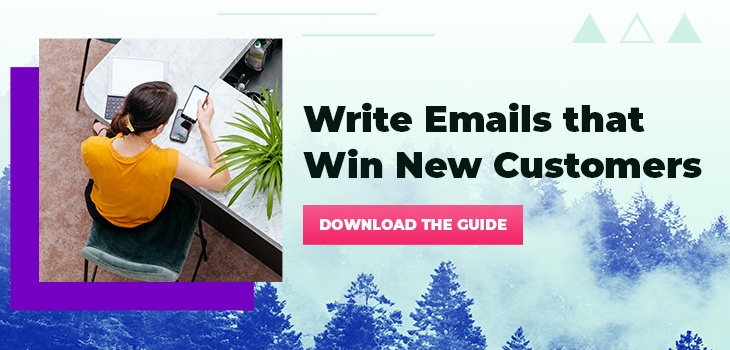How many of your first dates were also last dates? No second meeting, no phone call the next day, no “see you around.” Whether it was an awkward blind date or just a bad normal date, it probably ended there for a reason. Maybe one of you wasn't interested in learning more about the other, or there was no spark between you. Things happen, and that’s okay.
An email list is like an entire database of first dates. Every contact has seen some aspect of your brand, thought you were cute, and gave you their email address. Now you’ve probably sent them a welcome email like “We’re happy you’re here” and the two of you had a great first interaction.
What makes the best email lists stand out is their ability to get a second date. To re-engage prospects time and time again and keep them active members of an email list. You can be the brand people are excited to see in their inbox, but first you have to build your little black book of prospects.
How to Build Your Email List
Gathering a solid list of email subscribers is one of the most difficult parts of email marketing. Sure, you could buy a list, but that rarely pays off and you run the serious risk of getting flagged or blacklisted, which is difficult to reverse. Instead, you can try a few simple approaches to email list building by attracting the right people to your brand and making it easy to sign up.
Offer the Signup on Your Website
Your website is one of the best places to get people to join your email distribution list. If they're already on your website and engaging with you, chances are they’re willing to take the next step and won’t mind seeing an email signup form.
The key is to make signing up as easy as possible. Extra steps or complicated requirements will turn most people off. All you need to do is add a simple signup form to your blogs or other relevant pages where users can enter their email address and hit “Submit.” This form should be short—no more than three fields—so you're creating as little friction as possible.
You could also consider using pop-ups to promote your list throughout your site. You'll notice pop-up forms on a lot of e-commerce sites like Wayfair. Some of them even use an exit-intent popup that offers a discount in return for your email if you're about to leave the site. This is one way to focus on offering value in return for customers’ email addresses.
Use Social Media
Leveraging your existing social media presence to get people interested in your brand is an easy list-building strategy. Once they’re intrigued by what you have to offer, signing up for your email list will seem like the next logical step. Promote your list in social media profiles, mention it regularly in tweets and posts and even consider running some competitions or giveaways that motivate people to join your list.
Add An “Opt-in” Incentive
If you’re like me, you’re a bit tired of giving away your information in a web form. You probably have a “junk” email address you use so you aren’t bothered by the parade of marketing emails that flood your inbox every day, or you dismiss the offers altogether. I only use my primary email address if there’s something I truly want to read or download.
A great way to solve the pseudo-email problem is to create a lead magnet. You offer something of value (free ebook, guide, checklist, white-paper, etc.) in exchange for the visitor's information. All they have to do is fill out the opt-in form. This way you both get something of value and it feels like an equal trade to the user.
Maintaining Your List
Update The List Regularly
Things change all the time online. Your most interactive leads might suddenly ghost you or people who haven’t looked at your content for months will reenage. This kind of activity also means your email lists can quickly go out of date if you aren’t paying attention.
It’s important to consistently keep your email lists up to date so you know you’re reaching out to people who want to hear from you. As you comb through your list, you’ll probably notice that leads decay and unsubscribe in every update cycle. Don’t let this scare you. All it means if you need to keep up with lead generation efforts. Keep pursuing opportunities to add new addresses, so you’re constantly building enough contacts to make up for the leads that fall off your list.
List Segmentation
Let’s assume that you have a sizable email database, but all your addresses are in one giant list in your CRM. It’s likely composed of customers, prospects, old contacts, and a few “colleagues” who forced their card into your hand at happy hour. With all these different types of contacts in your database, would you send them all the same marketing email?
You could, but then you're missing out on the opportunity to offer something highly relevant to your prospect. And since we know the level of relevancy is directly related to the likelihood of getting someone to convert, why miss out on the opportunity?
Here are a few ways you can start segmenting your list so that you can send each target audience appropriate emails:
- Industry
- Buyer Persona
- Lifecycle Stage (lead, marketing qualified, sales qualified)
- Customers
Don’t be afraid to get granular with your segmentation as you grow your list. The more targeted you are with your email messaging and content offerings, the better your results will be.
Email Strategies to Activate Your Email List
When you activate your email list, you’ll start seeing an ROI on your email marketing. Why? Because you’ve created a direct line of communication with potential customers.
For the record, it’s fair to say you don’t enjoy getting spam phone calls and emails every day from people you don’t know. So don’t be that person for your prospects. Instead, be engaging, provide value and stay consistent.
Consider these strategies to activate your list.
Create Quality Email Content
Email lists serve a wide variety of marketing purposes. If one fails, it’s often because the brand doesn't pay enough attention to the quality of the content they’re sending out.
To provide valuable content, you need to know the purpose of your list before you start sending emails. What do you want to accomplish? What do you want to communicate? Once you have a basic idea of the purpose, create high-quality content that’s engaging and to the point. Keep things simple and focused on retaining people’s interest.
👉 Read More: Content Marketing 101: How to Build a Digital Content Strategy
Email Newsletter
Ideally, you’ll come up with something more creative than “newsletter,” but this term gets us on the same page. An email newsletter is a dynamic way to communicate with your email list, especially if you’re consistently posting relevant content. Set expectations about what the newsletter is and is not as soon as possible, then determine how often you’ll send.
But wait...why a newsletter? What do people want to hear from you?
Your reason to “reach out” should first be to provide value to your customers. Gary Vaynerchuk has a long list of things he’s known for, and two of my favorite mantras he frequently reiterates are “jab, jab, jab, right hook” and “the one who provides value, wins.” It’s awesome because it’s true.
Consider the 80/20 rule for your monthly newsletter. 80% of the content is providing value to the reader and 20% is reserved for a “promotion” or direct offer. Gary would argue and say the 99/1 rule, but you get the picture.
Need some newsletter inspiration? Here are 15 newsletters that are killing it.
Build a Blog
We’ve mentioned content a bunch of times, so by now you’re probably wondering where the heck you’re supposed to get all of this great material. The short answer: your blog.
Developing a blog with quality content has an incredible value. You can address your customers’ biggest frustrations, offer educational guides, share industry reports, feature case studies, the list goes on. Your blog gives you an opportunity to jump into the conversations that are taking place online and create original content from your brand perspective.
Whether you're looking at content upgrades or starting from scratch, it can help to build a framework for your blog before you get started. First, you want to determine the purpose of your posts. Do you want them to drive content marketing? Lead prospects to products? Link out to landing pages? Whatever this goal is, create a plan and structure that will get your users there with minimal friction and show them the value you could offer in your email campaigns if they join your list.
The blog isn’t limited to the sole function of collecting emails either. Each post you publish is like a marketing soldier helping to attract more visitors. The more soldiers, the bigger the army, and the bigger the army… well, you get it. There are also long-term SEO benefits to building your blog, but we won’t get into that right now.
Here’s the point: Your blog will attract new website visitors, and with the right calls-to-action, you can incentivize them to subscribe and receive content updates, newsletters, promotions and/or “insider information”.
Setting up blogs that boost conversion rates can be tricky, so here are 10 call-to-action ideas to get you started. If you’re still struggling to get visitors to convert, try these CTA optimization tips:
- Start with people you know. Previous customers, colleagues and any prospect’s business card you can find in your desk junk drawer.
- If you don’t have an email tool or CRM, consider platforms like Hubspot, Active Campaign, MailChimp, Sendgrid, Drip or Convertkit to help you set up and automate your email lists.
Offer And Promote Email Only Incentives
Consumers need an incentive to participate with online or email-based communication. To keep your list strong and alive, use it to offer email exclusive information, deals and promotions. Making people feel like part of the in-crowd is a time tested marketing strategy that really works. Create an exclusive club for loyal clients, and use your email distribution list as a gateway for unique content that will keep people coming back for more.
Once again, consistency is key here. If you don’t keep the incentives fresh and constant, then people may start looking elsewhere. Have a regular schedule for these promotions to make the best of this strategy.
Here are a few email promotion ideas:
- New Product Release: “We just launched something new, would you like to be in our beta program? Your feedback would be very helpful!” Don’t be surprised if they end up buying or forwarding the message to colleagues.
- Post-Script Hook: After signing off in your email, add a “PS:” line that subtly promotes a new lead magnet, blog post or transitional CTA that offers the reader a little something extra.
- Email Signature Share: Adding a share link in your email signature gives the reader an easy way to pass it along to someone else who might become a new subscriber.
- Cross-Promote: Similar to Amazon’s, “recommended for you” section, is there a product or service that current customers may find of value?
- Referral Promotion: Offer your loyal customers an exclusive deal when a friend signs up.
- Humble Brag: If your company has received an award or achieved a milestone, consider sending a company announcement. Just make sure it points back to how much you value your customers for helping you earn it. If done right, it will provide social proof to those who are still on the fence about you.
*Reminder: If you haven’t sent an email to your database yet, don’t start with a sales promotion. Set expectations for the newsletter and provide value before you send out a sales pitch (jab, jab, jab, right hook).
Marketing AI Tools That Will Help Optimize Your Email List
Marketing AI is growing fast and there are lots of tools that can be extremely effective and don’t require any mad-scientist prerequisites. Testing new technology is something we get an opportunity to do quite a bit. We’ve had great experiences with some and not so great ones with others.
Before you start signing up for free-trials left and right or getting into a black-hole of research, take a look at the Marketing Artificial Intelligence Institute. This has become our top resource for everything marketing AI. They’ve recently launched a new tool that allows you to explore and rate dozens of AI use cases and get personalized recommendations for AI-powered vendors. This assessment helped us tremendously. Try it here!
Email Send Optimization: Seventh Sense
You never have to send another “email blast” again. With Seventh Sense email automation, you send one email at a time to your entire list, delivering over a span of 3-5 days (you can adjust this) based on when they are most likely to open the email. It sounds crazy, but our results don’t lie!
This technology analyzes your data so it can predict when someone will open an email based on their contact engagement (open rates, click throughs, etc.) and contact history.
Email Subject Lines: Phrasee
Put your subject line copy to the test and compete with Phrasee, the email subject line generator. Their deep learning algorithms mixed with language generation is scary. In a good way. See for yourself!
There are plenty of Marketing AI tools out there that you can start trying, these are just a couple in the realm of email marketing that we like!
Where Does That Leave Us?
So, If you build it, will they come?
As much as I’d like to steal from one of the best baseball film monologues (notice I didn’t say “arguably”...) in Field of Dreams and say, “if you build it, they will come,” I won’t be able to make such a guarantee for you.
Here’s what we do know. Email isn’t going anywhere. But with all of today’s noise, push notifications, and alerts pinging at once, it’s more important now than ever to have a strategy in place for success. Let your emails be the call after the first date or the text asking if they want to grab coffee. As long as you’re providing value and are active in the relationship, your email list will support your success.









